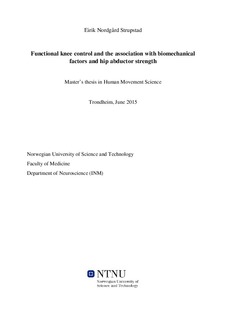| dc.description.abstract | Higher injury rates for knee anterior cruciate ligament (ACL) have been found in female athletes compared with males. Established risk factors for ACL injury include anatomy, external, hormonal and biomechanical factors. Non-contact ACL injuries can occur at landings, change in directions or rapid deceleration with the knee joint extended and rotational forces causing high loads on the ACL. Preventive effects of training programs have been documented and a protocol to assess movement patterns as functional or not functional is developed. The Functional Movement ScreenTM (FMSTM) detect weakness and instability in movement patterns. Low scoring points have been associated with increased risk of injury. Muscle strength is important for injury. In special, findings suggest that weakness in hip abductor muscles are associated with knee pain and increased knee valgus motions during jumping and side-cutting. Knee abduction moments have been associated prospectively with ACL injury and lack of strength in hip abductors might lead to compensatory activity in gluteal muscles, which alters biomechanics and increases ACL loading.
The purpose of this study was to investigate associations between an adapted FMS score, hip abduction strength and knee abduction moments. Thirty-one female handball players conducted baseline and post intervention testing where screening points, hip abduction strength and biomechanics of four different jump tasks was collected in a test laboratory. Participants were divided to intervention or control group. The intervention group conducted a training program (2 times/week for 8 weeks) focusing on hip abductor strength and neuromuscular control of knee and hip joints. Findings were moderate correlations between total FMS score and knee abduction moments in the take-off phase in a counter movement jump. Further, hip abduction strength was correlated with knee abduction moments at initial contact in an in-jump task and hip abduction strength was correlated with scoring points from a one-legged squat test. Analysis of change between baseline and post-test found weak and non-significant correlations between the three testing procedures. In conclusion, the adapted FMS score, hip abductor strength and biomechanical factors are moderately associated with each other. Moreover, these correlations were not found when analyzing change from baseline to post-test. The current results may indicate that screening for risk of ACL injury should include a comprehensive evaluation and different testing procedures. | nb_NO |
